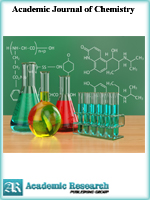Academic Journal of Chemistry
Online ISSN: 2519-7045
Print ISSN: 2521-0211
Print ISSN: 2521-0211
Quarterly Published (4 Issues Per Year)

Archives
Volume 5 Number 4 April 2020
Structural Analysis of Xanthan GUM-FE (III) Capsules
Authors: Elena Vázquez ; Sofía Piguillem ; Santiago Rubio ; Jorge Díaz ; Hector Baldoni ; Enrique Vega ; Martin Masuelli
Pages: 31-40
DOI: doi.org/10.32861/ajc.54.31.40
Abstract
In this work, the formation of capsules in xanthan gum and complexing solutions of Fe III is structurally evaluated. These capsules have a spheroid shape that, when dried, collapse into disc shapes. These spheroids are made up of microspheres that partially explain this collapse. The backscattered SEM image shows areas rich in Fe and others poorer in this metal, the EDX analysis confirms this. FTIR chromatograms show a clear shift at approximately 1620 cm-1 due to the formation of the xanthan gum-Fe III complex. This work also proposes a structure, theoretically demonstrated, between xanthan gum and Fe III, which can explain what the biopolymeric structure bending procedure is like due to the presence of Fe III, a model called TransbiHook.
Interacting Subsystems and Their Molecular Ensembles
Authors: Roman F. Nalewajski
Pages: 25-30
DOI: doi.org/10.32861/ajc.54.25.30
Abstract
The molecular density-partition problem is reexamined and the information-theoretic (IT) justification of the stockholder division rule is summarized. The ensemble representations of the promolecular and molecular mixed states of constituent atoms are identified and the electron probabilities in the isoelectronic stockholder atoms-in-molecules (AIM) are used to define the molecular-orbital ensembles for the bonded Hirshfeld atoms. In the pure quantum state of the whole molecular system its interacting (entangled) fragments are described by the subsystem density operators, with the subsystem physical properties being generated by the partial traces involving the fragment density matrices.



